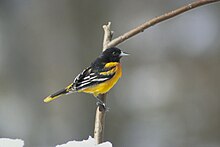| New World orioles | |
|---|---|

| |
| Baltimore oriole, Icterus galbula | |
| Scientific classification | |
| Domain: | Eukaryota |
| Kingdom: | Animalia |
| Phylum: | Chordata |
| Class: | Aves |
| Order: | Passeriformes |
| Family: | Icteridae |
| Genus: | Icterus Brisson, 1760 |
| Type species | |
| Oriolus icterus (Venezuelan troupial) Linnaeus, 1766
| |
| Species | |
|
See text | |
New World orioles are a group of birds in the genus Icterus of the blackbird family. Unrelated to Old World orioles of the family Oriolidae, they are strikingly similar in size, diet, behavior, and strongly contrasting plumage. As a result, the two have been given the same vernacular name.
Males are typically black and vibrant yellow or orange with white markings, females and immature birds duller. They molt annually. New World orioles are generally slender with long tails and a pointed bill. They mainly eat insects, but also enjoy nectar and fruit. The nest is a woven, elongated pouch. Species nesting in areas with cold winters are strongly migratory, while subtropical and tropical species are more sedentary.
The name "oriole" was first recorded (in the Latin form oriolus) by the German Dominican friar Albertus Magnus in about 1250, which he stated to be onomatopoeic, from the song of the European golden oriole.
One of the species in the genus, Bahama oriole, is considered endangered, formerly critically endangered, by the International Union for Conservation of Nature.[1]
The genus Icterus was introduced by the French zoologist Mathurin Jacques Brisson in 1760 with the Venezuelan troupial as the type species.[2][3] The name is the Latin word for a yellow bird, probably the Eurasian golden oriole.[4]
The genus name Icterus, as used by classical authors, referred to a bird with yellow or green plumage. Icterus is from Greek ἴκτερος (íkteros, “jaundice”); the ictērus was a bird the sight of which was believed to cure jaundice, perhaps the Eurasian golden oriole.[5] Brisson re-applied the name to the New World birds because of their similarity in appearance.[6]
- ^ BirdLife International (2021). "Icterus Northrop". IUCN Red List of Threatened Species. 2021: e.T22736369A197193663. doi:10.2305/IUCN.UK.2021-3.RLTS.T22736369A197193663.en. Retrieved 27 October 2024.
- ^ Brisson, Mathurin Jacques (1760). Ornithologie, ou, Méthode contenant la division des oiseaux en ordres, sections, genres, especes & leurs variétés (in French and Latin). Paris: Jean-Baptiste Bauche. Vol. 1 p. 30, Vol. 2 p. 85.
- ^ Paynter, Raymond A. Jr, ed. (1968). Check-List of Birds of the World. Vol. 14. Cambridge, Massachusetts: Museum of Comparative Zoology. p. 149.
- ^ Jobling, James A. (2010). The Helm Dictionary of Scientific Bird Names. London: Christopher Helm. pp. 201–202. ISBN 978-1-4081-2501-4.
- ^ ictĕrus in Charlton T. Lewis and Charles Short (1879) A Latin Dictionary, Oxford: Clarendon Press.
- ^ Newton, Alfred (1911). . In Chisholm, Hugh (ed.). Encyclopædia Britannica (11th ed.). Cambridge University Press.